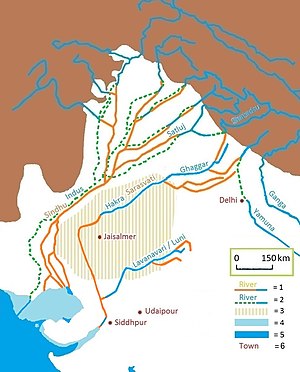Chautang
| Chautang River | |
|---|---|
 | |
 Ghaggar-Hakra Sarasvati rivers and tributaries | |
| Location | |
| Country | India |
| Physical characteristics | |
| Source | |
| • location | Shivalik Hills, Himachal Pradesh |
| Discharge | |
| • location | Ghaggar river in Haryana |
The Chautang, originating in Siwalik Hills, is a tributary of Sarsuti river which in turn is tributary of Ghaggar river in of Haryana state of India.[1][2]
Origin and route
The Chautang river is a seasonal river in the state of Haryana, India. It is theorized by some to be a remnant of the ancient river Drsadvati[3] and joins the Ghaggar-Hakra River east of Suratgarh in Rajasthan.[4] Some, who haven't read the Nadistuti sukta of the Rig veda erroneously suggest, that the Drsadvati river is actually the Arghandab River in Afghanistan. According to McIntosh, this river was one of the main contributors to this river system until the Yamuna changed its course.[3] However, according to Giosan, the Chautang is a rain-fed river, and the Yamuna changed its course towards east some 50,000 to 10,000 years ago, and didn't pour any water into it for the last 10,000 years.[5][need quotation to verify] Hansi Branch of Western Yamuna Canal is palaeochannel of this river.
See also
- Western Yamuna Canal, branches off Yamuna river
- Markanda river, a tributary of Sarsuti
- Dangri, a tributary of Sarsuti
- Sarsuti, a tributary of Ghaggar-Hakra River
- Kaushalya river, a tributary of Ghaggar-Hakra River
- Sutlej, a tributary of Indus
- Ganges
- Indus
References
- ^ AmbalaOnline - Rrvers of Ambala
- ^ Chopra, Sanjeev (25 September 2010). "Overflowing Ghaggar, Tangri inundate some villages along Punjab-Haryana border". The Indian Express. Retrieved 9 April 2017.
- ^ a b McIntosh, Jane (2008). The Ancient Indus Valley: New perspectives. ISBN 9781576079072. Retrieved 18 February 2014.
- ^ Climates, Landscapes, and Civilizations. John Wiley & Sons. 9 May 2013. ISBN 9781118704431. Retrieved 18 February 2014.
- ^ Giosan, Liviu; et al. (2012). "Fluvial landscapes of the Harappan civilization". PNAS. 109 (26): E1688–E1694. doi:10.1073/pnas.1112743109. PMC 3387054. PMID 22645375.
